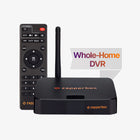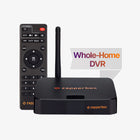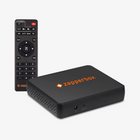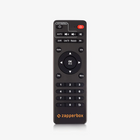Yes. All ZapperBox models with tuners work with all encrypted channels in all markets. Our current implementation of content security requires an Internet connection. Content security without an Internet connection will be supported soon with a software update. Recording and playback of secure content on an HDMI connected TV is also supported (see DVR profile below). Playback of encrypted recordings and encrypted Live TV on connected devices will be supported starting with the v4.0 software release (see gateway profile below). We regularly update our release notes page to announce dates for such updates. If you are not on our mailing list, please register for our newsletter using the “Newsletter Sign Up” block on our website.
There are three security profiles for ATSC 3.0 receivers:
- Tuner profile - we added support for this with software version 2.2 on Oct 18, 2023.
- DVR profile - we added support for this with software version 2.5 on Apr 9, 2024.
- Gateway profile - we plan to add support for this with software version 4.0 during December 2025.
While v4.0 will add support for ZapperBox devices to watch encrypted content from any room in a home, future versions will support ZapperBox apps that work on devices made by other OEMs like Sony, Roku, LG, Samsung, etc. See our roadmap for this at this link.
Why are we bothering with DRM? We believe that OTA TV is withering and content is moving behind paywalls due to a lack of content protection. Free over-the-air TV is funded by advertisers. If everyone can record premium content and skip commercials, it leads to a "tragedy of the commons". DRM is required to prevent a two-tier TV system where OTA broadcasts only carry reruns or live HD content with Dolby Surround audio (ATSC 1.0) while premium content and live shows with 4K, HDR and Dolby Atmos are only available on paid streaming services like YouTube TV or Netflix.
As ZapperBox, our interest lies in making sure that the OTA ecosystem survives and thrives. This can happen if broadcasters remove content from behind paywalls and put it back on OTA supported by ad revenue. This is why we are implementing DRM rather than fighting it.
Following are some controversial aspects of DRM along with our musings:
- Should broadcasters be able to limit how long a recording can be retained? No. While YouTube TV allows one to keep recordings for only 270 days. There is a difference, YouTube TV recordings are stored in the cloud on storage belonging to YouTube. If a home user makes a recording on personal storage, they should be able to retain it for personal use as long as they want.
- Should a broadcaster be able to prohibit recordings of free-to-air programs? No. Such recordings are already protected by DRM.
- Should viewers be able to view their recordings or live TV using apps on their smart devices when they are traveling away from home? Yes. Viewing recordings and live TV, strictly for personal use, should be permitted when one is away from home. A prohibition on remote viewing is called geofencing.
- Should broadcasters be able to replace the ads within DRM protected recordings? Yes.
- Can broadcasters use DRM to launch paid services? Based on our AI guided research, FCC rules explicitly require that any main programming stream offered over ATSC 3.0 must remain available for free to the public, just as it is on today’s ATSC 1.0 broadcasts. Broadcasters are permitted to offer additional “ancillary or supplementary services”—such as datacasting or premium, non-broadcast video—that could be paid/subscription-based, but these must not replace the required free primary channel and must comply with separate regulatory requirements and fees. Much more about this topic can be researched from the ATSC document at this link. Further, FCC restrictions requiring that broadcasters' main ATSC 3.0 programming streams remain free to the public—mirroring today's over-the-air broadcast rules—are not tied solely to the current simulcast period. These requirements are a core part of the FCC's broadcast public interest obligations and would continue to apply even after the simulcast (ATSC 1.0/3.0) mandate sunsets, unless the FCC takes explicit action to alter them.




